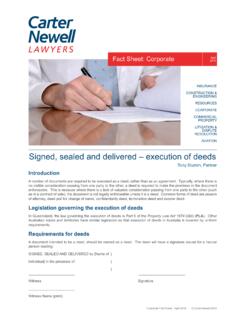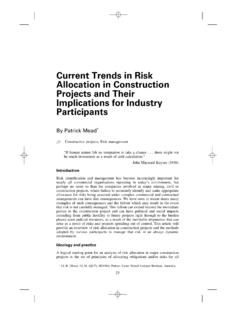Transcription of Current Trends in Risk Allocation in Construction …
1 Current Trends in Risk Allocation in Construction Projects and their implications for Industry Participants By Patrick Mead*. Construction projects; Risk management If human nature felt no temptation to take a chance .. there might not be much investment as a result of cold calculation.. John Maynard Keynes (1936). Introduction Risk identification and management has become increasingly important for nearly all commercial organisations operating in today's environment, but perhaps no more so than for companies involved in major mining, civil or Construction projects, where failure to accurately identify and make appropriate allowance for risks being assumed under complex commercial and contractual arrangements can have dire consequences.
2 We have seen in recent times many examples of such consequences and the fallout which may result in the event that risk is not carefully managed. This fallout can extend beyond the immediate parties to the Construction project and can have political and social impacts extending from public hostility to future projects right through to the burden placed upon judicial resources, as a result of the inevitable disputation that can arise as a result of risks and projects spiralling out of control. This article will provide an overview of risk Allocation in Construction projects and the methods adopted by various participants to manage that risk in an always dynamic environment.
3 Ideology and practice A logical starting point for an analysis of risk Allocation in major Construction projects is the set of principles of allocating obligations and/or risks for all (Hons), (QUT), MIAMA; Partner, Carter Newell Lawyers Brisbane, Australia. 23. 24 Construction Law Journal projects expounded by the international Construction lawyer Max Abrahamson, referred to as the Abrahamson principles . Those principles suggest that a party to a contract should bear a risk where: the risk is within the party's control;. the party can transfer the risk, through insurance, and it is most economically beneficial to deal with the risk in this fashion;. the preponderant economic benefit of controlling the risk lies with the party in question.
4 To place the risk upon the party in question is in the interests of efficiency, including planning, incentive and innovation efficiency;. if the risk eventuates, the loss falls on that party in the first instance and it is not practicable, or there is no reason under the above principles, to cause expense and uncertainty by attempting to transfer the loss to These principles have not already translated into practice, however. A study of major Construction contracts for example found that: risks were not allocated to the party best able to manage the risk;. formal risk assessments were not being undertaken;. risk clauses varied from those in standard contracts.
5 risks were transferred to consultants and contractors which were impos- sible for them to manage;. risks were not costed in tenders;. cost savings would have occurred had risks been more effectively allocated;. the implications of changing risk Allocation were not known;. disputes and claims increased as a consequence of changes to risk Perhaps more hopeful are the results of a more recent survey concerning the usage of risk management techniques, which indicated that: the use of risk management is moderate to high, with very little differ- ences between the types, sizes and risk tolerance of the organisations, and experience and risk tolerance of the individual respondents.
6 Risk management usage in the execution and planning stages of the project life cycle is higher than in the conceptual or termination phases;. 1 See NPWC/NBCC report, No Dispute Strategies for improvement in the Australian Building and Construction Industry , May 1990. 2. Engineers Australia and the Chamber of Commerce and Industry of Western Australia, Effective Risk Allocation in Major Projects: Rhetoric or Reality , 2001, extracted from a paper by David Singleton, Chair National Engineering Registration Board, Process for Resolving Technically Complex Disputes . (2007) 23 Const. No. 1 Sweet & Maxwell Ltd and Contributors Current Trends in Risk Allocation in Construction Projects 25.
7 Risk identification and risk assessment are the most often used risk management elements ahead of risk response and risk documentation;. brainstorming is the most common risk identification technique used;. qualitative methods of risk assessment are used most frequently;. risk reduction is the most frequently used risk response method, with the use of contingencies and contractual transfer preferred over insurance;. project teams are the most frequent group used for risk analysis, ahead of in-house specialists and Multidisciplinary approach The use of a project team to undertake risk analysis appears to be one of the key Trends to have emerged in recent years and it is clearly necessary to take a holistic approach that focuses not only on legal risks but the myriad technical, commercial, regulatory and process risks likely to be encountered.
8 Accordingly a legal risk assessment is likely to comprise only one aspect of assessments which should be made, involving a variety of professionals drawn from other disciplines, both in-house and sometimes externally. The diagram below illustrates the types of consultants which might be engaged for risk analysis (in the context of a PFI project process), highlighting the choices of the different industry stakeholders. One of the things demonstrated by this diagram is that the risks which the various stakeholders consider as most significant to them will guide their focus on risk management, the Allocation of those risks and their choice of disciplines called upon to inform their decision-making process.
9 The perception of risk what constitutes a risk in the first place and the reaction of a particular party to it will often be informed by past experiences and influenced by value systems, both personal and organisational. Hence a contractor in a competitive tendering situation may feel that it is being asked to assume risks over which it has no control, while at the same time the principal may consider that those risks have been allocated to the party best able to manage The financier, on the other hand, its perception of risk being driven by the nature of the financing itself and the focus on completion risk, may seek to allocate maximum risk to the contractor for the good of cash flow insisting on an Allocation of risk even more narrow than that which might otherwise have been negotiated between industry participants.
10 Risk management Risk management involves the identification, mitigation and evaluation of Risk management has been defined as the culture, processes and structures that 3 Terry Lyons and Martin Skitmore, Source project Risk Management in the Queensland Engineering Construction Industry: A Survey , School of Construction Management and Property, Queensland University of Technology, November 5, 2002. 4 As suggested by the result of the 2001 survey conducted by the Chamber of Commerce &. Industry of Western Australia and the Institution of Engineers Australia: Effective Risk Allocation in Major Projects: Rhetoric or Reality? 2001 . 5 Steele A., Audit Risk & Audit Evidence: The Bayesian Approach to Statistical Auditing, (Academic Press, London, 1992).













